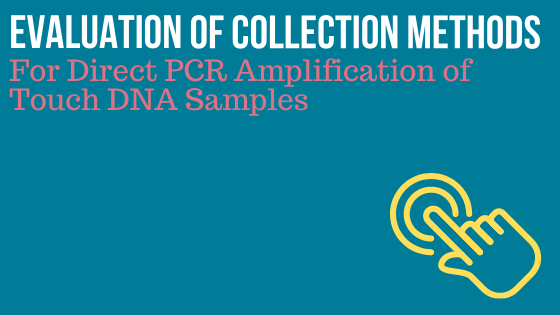Direct polymerase chain reaction (PCR) amplification, a sample processing method in which an evidence swab or substrate punch is added directly to an amplification reaction without prior extraction or quantification, has been identified as a method that may improve DNA profiles from low-yield touch DNA evidence. Small amounts of DNA left behind when an individual comes in contact with an object are referred to as touch DNA, and it can be challenging to obtain DNA profiles from this type of sample. Direct PCR maximizes the amount of DNA template in a reaction by eliminating the DNA loss that occurs during DNA extraction, quantification, and concentration; however, the amount of DNA available for direct PCR can be affected by the method used for DNA sample collection.
Written by: Anna SalmonsEn, MFS, Bode Technology
Our goals were to identify collection methods that maximize touch DNA recovery from common substrates and to compare the results from direct PCR and standard processing methods. Touch samples from three donors were deposited on various substrates, including denim fabric, wool fabric, polyester fabric, plastic microscope slides, metal tools, handgun grips, vinyl shutters, brass cartridge casings, foam cups, concrete bricks, and unfinished wooden tool handles. DNA was collected from the non-fabric substrates with Puritan® cotton swab cuttings (3.0 mm), Copan microFLOQ® swabs (whole swab head), or Whatman™ FTA paper punches (1.2 mm) that were moistened with sterile water, moistened with 0.1% Triton X-100™, or left dry. Fabrics were cut into 2 mm2 sections. In total, 3,376 samples were processed with either: (1) standard processing with DNA extraction, concentration, and quantification prior to amplification or (2) direct PCR. The extracted and direct PCR samples were amplified with GlobalFiler™. No changes were made to the thermal cycling parameters, reaction mixtures, or reaction volumes validated for regular casework (25 µl reactions, 29 cycles).
In general, direct PCR produced DNA profiles that were comparable to standard processing without requiring specialized amplification kits or modifications to the validated amplification SOPs, although direct PCR success was highly dependent on the substrate from which samples were collected. Direct PCR profiles exhibited alleles above the analytical threshold for samples collected from plastic slides, polyester fabric, metal tools, handgun grips, vinyl shutters, foam cups, and unfinished wooden tool handles. MicroFLOQ swabs were found to be the most effective and user-friendly collection substrate for direct PCR. MicroFLOQ swabs & water or Triton X-100 produced the highest quality direct PCR profiles for plastic slides, handgun grips, and vinyl shutters, whereas dry microFLOQ swabs produced the highest quality direct PCR profiles for metal tools, foam cups, and unfinished wooden tool handles. Direct PCR was unsuccessful for samples collected from substrates with known inhibitors (i.e., concrete bricks, cartridge casings, denim, wool blend, and 100% wool), regardless of the method used for collection. Further optimization of the PCR reactions may improve results for these substrates. Regardless of the collection and processing methods used, all touch DNA samples contained highly variable quantities of DNA.
Our results demonstrated that direct PCR with GlobalFiler can be an effective method for processing touch DNA samples collected from substrates that do not contain known inhibitors. Although significant improvements in profile quality were generally not observed, direct PCR was less time consuming and expensive than standard processing; therefore, when equivalent results can be obtained, direct PCR may be an advantageous option for laboratories processing touch DNA samples. We were also able to recommend touch DNA sample collection methods for a variety of commonly encountered substrates.
Currently, direct PCR cannot be used for evidentiary samples in the United States, in part due to FBI Quality Assurance Standard (QAS) 9.4, which requires all unknown forensic samples to undergo human-specific DNA quantitation prior to amplification. We hope that the data from this project will highlight the benefits and limitations of direct PCR for touch DNA samples and will provide a foundation for further research, particularly when considered with the existing literature on direct PCR. In the event that FBI QAS 9.4 is changed, the results from such studies will provide laboratories with a useful roadmap for proceeding with their own direct PCR evaluations and internal validations.
As a graduate student pursuing my MFS in Forensic Molecular Biology at The George Washington University, I had the opportunity to work as a Research Fellow at Bode Technology where I contributed to this project. The challenges associated with obtaining usable and reliable DNA profiles from touch DNA samples and the benefits of improving touch DNA processing methods captured my interest. I have since completed my degree and have been hired as a full-time Validation Scientist at Bode. I recently contributed to the validation of the new Bode X-traction™ method for recovering DNA from spent shell casings and rootless hairs. Currently, I am working on validating new SOPS for robotic automation of various laboratory procedures. I am excited that I will be able to continue my direct PCR research in my new role.
I am now working on the second phase of this project, which will include an examination of the effectiveness of direct PCR on swabs stored for up to six months after sample collection, a comparison of direct PCR performed with GlobalFiler and PowerPlex® Fusion 6C amplification kits, an evaluation of reagents to optimize the amplification of challenging samples and minimize PCR inhibition, and an evaluation of the efficacy of direct PCR on samples that have been re-swabbed after initial analysis is completed. Evaluating the effectiveness of direct PCR on swabs stored after collection is crucial as forensic DNA evidence is not always processed immediately after collection. Exploration of the secondary sampling technique may help alleviate concerns regarding the ability to re-analyze direct PCR samples in the event that a drop-in event is observed, an issue arises with the amplification controls, an off-ladder microvariant is observed, or third-party defense testing has been requested.
This project was supported by Award No. 2019-DU-BX-0009, awarded by the National Institute of Justice, Office of Justice Programs, U.S. Department of Justice. The opinions, findings, and conclusions or recommendations expressed in this exhibition are those of the authors and do not necessarily reflect those of the Department of Justice.
WOULD YOU LIKE TO SEE MORE ARTICLES LIKE THIS? SUBSCRIBE TO THE ISHI BLOG BELOW!
SUBSCRIBE NOW!


